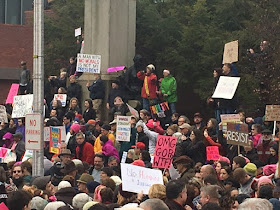Thankfully the BBJ picked the matter up in an online article today headlined "City Crescent redevelopment could hamper Howard St. access, city official says". As the BBJ points out, only the Mayor can stop the bill now.
The bill would eliminate the public right of way that has been carried underneath the Crescent building on Howard Street. The building design and the Central Light Rail Line to Camden Yards were carefully coordinated some 28 years ago. Allowing access to the train station under the Crescent building was an important issue for this LRT stop in front of the Arena. It was a compromise that permitted the Crescent building to span over the City's public right of way and still recognize the historic axis of Redwood Street.
Councilman Costello's bill would give this public right of way away for nothing by falsely stating in his bill that the easement "is no longer needed for public use".
 |
| The Crescent Building emphasizes the Redwood passageway in its facade design. |
This statement is not only incorrect, because nothing has changed in terms of the needed access to the light rail station, it is also willfully ignorant of the principles of transit oriented development, good urban planning and the needs of pedestrians and transit users. It blatantly puts the perceived interest of a real estate developer ahead of everything else.
"By releasing the easement, the City will aid and promote the development of the propject on the property, which will inure to the benefit of the City" (Recitals of bill 19-0469)Planning Director Ryer begs to differ in a letter sent to the City Council on January 23, 2020. He correctly wonders how it could be possible to suggest that such a mayor building would turn away from transit and from a major downtown artery such as Howard Street.
The elimination of easement access and creation of the buildings main entrance on the Redwood Street and alley side of the building turns its back to a major Baltimore Street and disconnects the activity of the building away from the public environment. The department of Planning respectfully recommends disapproval [of the bill]. (Chris Ryer)Ryer is exactly right: Turning a building and its entrance away from a transit stop right there flies in the face of the principles of transit oriented development. The original Crescent, the Center Development up the street and the development of Symphony Center were touted as TOD and were the only examples of intensified land use along the new light rail line. It would be ironic to come back 28 years later where the need for TOD is much better understood and eradicate one of the few early transit friendly development initiatives city planners had at the time.
1904 view of Redwood Street (looking west from Guilford Ave)
 |
| The Crescent Building and the Arena at Howard Street (Photo BBJ) |
At stake is also Redwood Street, or better what is left of what was once one of the most important streets in Baltimore's downtown. The street, once named German Street has become the victim of urban renewal with its idea of "superblocks" which is long considered obsolete. Redwood Street ends on the west at Martin Luther King Boulevard and on the east at South Street. Where it exists it is lovely and lined by historic buildings. But it has been wiped out in three segments by the University of Maryland, the Arena, and Center Plaza, all three interventions not exactly known for architectural beauty or urban design sensibilities.
The 315,000 sf Crescent Building was originally designed as a hub of federal offices and been developed by Theo Rogers and Otis Warren. It was the first time a black owned team developed a showcase project downtown. Last year the flagship project was fully vacant and auctioned off for less than its cost in 1990. The new owner wants to redevelop it into a mixed used project.
 |
| The passage which recognizes Redwood Street is protected by a public right of way which Councilman Costello wants to give away (photo BBJ) |
As someone who was involved with the design of the light rail line on Howard Street and the Arena Station station specifically, I recall how the station pylon was placed on the axis of Redwood Street and how access from the west was seen as a vital issue that also found its representation in the design of the facade of the Crescent Building. The Sun's architectural writer, Ed Gunts wrote in 1990" "The arrival of the new federal building (the Crescent) should lead to a frank evaluation of the Baltimore Arena."
My office later investigated options for the redevelopment of the Arena site, should a new Arena be built at a different location as it was once proposed. A central idea was a reconstruction of the street grid with a reopened Redwood Street west of Howard Street.
Since the Arena question remains unresolved, this option should be maintained so that in the long run east west circulation through the westside of downtown can be improved for easier walking and getting around. Superblocks need to be broken up and not cemented into the future, as this misguided bill would do it.
Klaus Philipsen, FAIA













